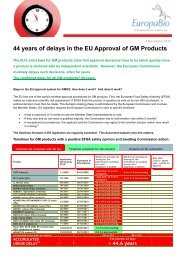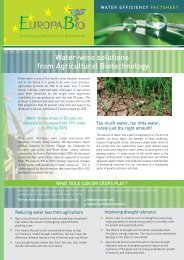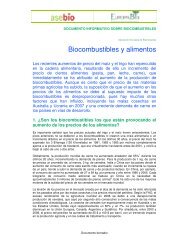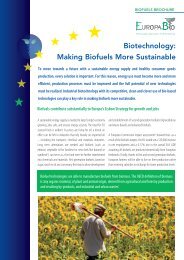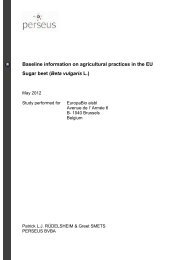18 8. REGULATORY COSTS The average cost for hav<strong>in</strong>g <strong>GM</strong>Os approved <strong>in</strong> <strong>Europe</strong> has been estimated at ¤7-10 million 46 per event. These costs ma<strong>in</strong>ly accrue from <strong>the</strong> large number of studies which <strong>the</strong> applicant companies have to present to EFSA. The 30 approvals (<strong>in</strong>clud<strong>in</strong>g for imports) hav<strong>in</strong>g been granted by April 2011 represent total costs to companies of between ¤210 and 300 million. This does <strong>not</strong> <strong>in</strong>clude <strong>the</strong> costs for <strong>the</strong> 73 <strong>GM</strong> products which were <strong>in</strong> different stages of <strong>the</strong> approval system <strong>in</strong> April 2011. Indirect costs result from unpredictable timel<strong>in</strong>es, which can take up to 13 years for <strong>GM</strong> cultivation applications and 47 months for import applications, as well as frequent, sometimes retroactive, changes <strong>in</strong> <strong>the</strong> requirements. For example, for dossiers submitted <strong>in</strong> 1998, EFSA was still ask<strong>in</strong>g new questions <strong>in</strong> 2011. With equally thorough requirements, yet swifter approvals <strong>in</strong> o<strong>the</strong>r parts of <strong>the</strong> world, and an <strong>in</strong>creas<strong>in</strong>g backlog <strong>in</strong> <strong>Europe</strong>, <strong>the</strong> result is an uneven play<strong>in</strong>g field for companies. Some ideas to improve this situation are be<strong>in</strong>g discussed. 9. CONCLUSIONS 1. Wherever <strong>the</strong>y are allowed to, millions of farmers choose to cultivate <strong>GM</strong> <strong>crops</strong>. They derive socio-economic <strong>benefits</strong> from <strong>the</strong>ir use. If farmers did <strong>not</strong> get a suitable return, <strong>the</strong>y would <strong>not</strong> cont<strong>in</strong>ue to cultivate <strong>GM</strong>. 2. Higher productivity on <strong>the</strong> same amount of land is an important contri<strong>but</strong>ion to susta<strong>in</strong>able agriculture. O<strong>the</strong>r large scale environmental <strong>benefits</strong> of <strong>GM</strong> <strong>crops</strong> have been proven and documented widely. 3. <strong>Europe</strong>an farmers choose to cultivate <strong>GM</strong> <strong>crops</strong> where <strong>the</strong>y are allowed to and where <strong>the</strong>y benefit from <strong>the</strong>ir use. With EU cultivation limited ma<strong>in</strong>ly to Bt maize, it is clear that <strong>the</strong> ma<strong>in</strong> <strong>benefits</strong> are limited to regions most affected by <strong>the</strong> target pest, <strong>the</strong> <strong>Europe</strong>an corn borer. 4. <strong>Europe</strong>an farmers are miss<strong>in</strong>g economic opportunities worth between ¤443 to ¤929 million each year. 5. <strong>Europe</strong> is dependent on gra<strong>in</strong> imports, most of which are <strong>GM</strong>. A slow approval process and trade barriers <strong>in</strong> <strong>Europe</strong> make imports of <strong>GM</strong> products more expensive and could result <strong>in</strong> major trade disruptions. 6. Many new <strong>crops</strong> are rapidly be<strong>in</strong>g developed and authorised around <strong>the</strong> world. Accord<strong>in</strong>g to <strong>the</strong> <strong>Europe</strong>an Commission’s Jo<strong>in</strong>t Research Centre, <strong>the</strong> number of commercial <strong>GM</strong> <strong>crops</strong> is set to <strong>in</strong>crease to 120 or more by 2015. As new <strong>crops</strong> are released, which may <strong>in</strong>clude salt tolerant, drought tolerant, nitrogen efficient and nutritionally enhanced varieties, it seems unlikely that <strong>the</strong> EU can reasonably cont<strong>in</strong>ue with its current approach. 7. Socio-economic factors can<strong>not</strong> be taken <strong>in</strong>to account when approv<strong>in</strong>g <strong>GM</strong> <strong>crops</strong>.
10. SOURCES 1 Reuters, 15 April 2011, Socio-economic impact of <strong>GM</strong> <strong>crops</strong> unclear: EU exec 2 James, C (2010) Global Status of Commercialized Biotech/<strong>GM</strong> Crops: 2010. ISAAA-brief 42 3 EU number of farms and arable land: Eurostat: http://epp.eurostat.ec.europa.eu/cache/ITY_OFFPUB/KS-ED-10-001/EN/KS-ED-10-001-EN.PDF 4 James, C (2010) Global Status of Commercialized Biotech/<strong>GM</strong> Crops: 2010. ISAAA-brief 42 5 Brookes, G., Barfoot, P. (2011) <strong>GM</strong> <strong>crops</strong>: global socio-economic and environmental impacts 1996-2009: http://www.pgeconomics.co.uk/page/29/susta<strong>in</strong>able,-profitable-and-productive-agriculture-cont<strong>in</strong>ues-to-be-boosted-by-<strong>the</strong>-contri<strong>but</strong>ion-of-biotech-<strong>crops</strong> 6 Brookes, G., Barfoot, P. (2009a) Global Impact of Biotech Crops: Income and Production Effects, 1996-2007. AgBioForum, 12, 184-208 (http://www.pgeconomics.co.uk/pdf/2009socioeconimpactsagbioforumpaper.pdf 7 James, C (2010) Global Status of Commercialized Biotech/<strong>GM</strong> Crops: 2010. ISAAA-brief 42 8 Brookes, G., Barfoot, P. (2011) <strong>GM</strong> <strong>crops</strong>: global socio-economic and environmental impacts 1996-2009: 9 James (2010); Number of farmers <strong>in</strong> <strong>Europe</strong>. EuropaBio estimate 10 Kaphengst, T.; El Benni, N.; Evans, C.; F<strong>in</strong>ger, R. ; Herbert, S.; Morse, S.; Stupak, N. (2010): Assessment of <strong>the</strong> economic performance of <strong>GM</strong> <strong>crops</strong> worldwide. Report to <strong>the</strong> <strong>Europe</strong>an Commission, March 2011. http://ec.europa.eu/food/food/biotechnology/reports_studies/docs/swp_socio_economic_report_<strong>GM</strong>O_en.pdf 11 Brookes, G., Barfoot, P., (2009c) Focus on environmental Impacts, http://www.pgeconomics.co.uk/pdf/focusonenvimpacts2009.pdf 12 Brookes, G., Barfoot, P., (2011) <strong>GM</strong> <strong>crops</strong>: global socio-economic and environmental impacts 1996-2009: 13 Brookes, G., Barfoot, P., (2011) <strong>GM</strong> <strong>crops</strong>: global socio-economic and environmental impacts 1996-2009: 14 Demont, M., Dillen, K., Tollens E. (2007) <strong>GM</strong> <strong>crops</strong> <strong>in</strong> <strong>Europe</strong>: How much value and for whom? EuroChoices 6, 46-53 15 COGEM (2011), Drivers of Consolidation <strong>in</strong> <strong>the</strong> Seed Industry and its Consequences for Innovation 16 Biotech Crops <strong>in</strong> India: The Dawn of a New Era, Excerpted from The Global Status of Commercialized Biotech/<strong>GM</strong> Crops: 2008. ISAAA Brief No. 39. ISAAA South Asia office, New Delhi, India, 2009. 17 Brookes, G., Barfoot, P., (2011) <strong>GM</strong> <strong>crops</strong>: global socio-economic and environmental impacts 1996-2009 18 Brookes, G., Barfoot, P., (2011) <strong>GM</strong> <strong>crops</strong>: global socio-economic and environmental impacts 1996-2009 19 Kleter, G.A., Bhula, R., Bodnaruk, K., Carazo, E., Felsot, A.S., Harris, C.A., et al (2007) Altered pesticide use on transgenic <strong>crops</strong> and <strong>the</strong> associated general impact from an environmental perspective. Pest Manag Sci 53:1107–1115 20 Sankula, S., Marmon, G. and Blumenthal, E., Biotechnology-Derived Crops Planted <strong>in</strong> 2004 – Impacts on US Agriculture. National Center for Food and Agricultural Policy, Wash<strong>in</strong>gton, DC (2005). http://www.ncfap.org/whatwedo/pdf/2004biotechimpacts.pdf 21 Marvier, M., McCreedy, C., Regetz, J., Kareiva, P. (2007) A Meta-Analysis of Effects of Bt Cotton and Maize on Nontarget Invertebrates. Science 316,1475-1477 22 Carpenter, J. (2011). Impacts of <strong>GM</strong> <strong>crops</strong> on biodiversity. <strong>GM</strong> Crops 2:1, 1-17. 23 <strong>Europe</strong>an Commission (2001), EC-Sponsored Research on Safety of Genetically Modified Organisms, http://ec.europa.eu/research/quality-of-life/gmo/ ; <strong>Europe</strong>an Commission (2010a), A decade of EU funded <strong>GM</strong>O research, http://ec.europa.eu/research/biosociety/pdf/a_decade_of_eu-funded_gmo_research.pdf 24 A detailed overview of damage levels per country can be found <strong>in</strong>: Brookes, G. (2009c) The exist<strong>in</strong>g and potential impact of us<strong>in</strong>g <strong>GM</strong> <strong>in</strong>sect resistant (<strong>GM</strong> IR) maize <strong>in</strong> <strong>the</strong> <strong>Europe</strong>an Union. PG Economics Ltd. (http://www.pgeconomics.co.uk/pdf/btmaizeeuropejune2009.pdf) 25 Brookes, G., Barfoot, P., (2011) <strong>GM</strong> <strong>crops</strong>: global socio-economic and environmental impacts 1996-2009 26 Gómez-Barbero, M., Berbel, J., Rodríguez-Cerezo, E. (2008a) Adoption and performance of <strong>the</strong> first <strong>GM</strong> crop <strong>in</strong>troduced <strong>in</strong> EU agriculture: Bt maize <strong>in</strong> Spa<strong>in</strong>. Jo<strong>in</strong>t Recearch Centre report (http://ftp.jrc.es/EURdoc/JRC37046.pdf); Gómez-Barbero, M., Berbel, J., Rodríguez-Cerezo, E. (2008b) Bt corn <strong>in</strong> Spa<strong>in</strong>— <strong>the</strong> performance of <strong>the</strong> EU’s first <strong>GM</strong> crop. Nature Biotechnology 26, 384 – 386 27 Esteban, E. (2009) Experience with a <strong>GM</strong> crop cultivation by a Member State: Spa<strong>in</strong>. Presentation at EFSA Conference – Assess<strong>in</strong>g risks of <strong>GM</strong>Os, 14-15 September 2009. (http://www.efsa.europa.eu/en/events/documents/6.PresentationframeEs<strong>the</strong>rEsteban,0.pdf) 28 Antama (2009): Press release by fundacion Antama: http://fundacion-antama.org/wp-content/uploads/2011/01/20110110-NP-ANTAMA-estudio-mark<strong>in</strong>-EN.pdf 29 Gomez-Barbero et al (2008a, 2008b) as well as Gómez-Barbero, M., Rodríguez-Cerezo, E. (2007) <strong>GM</strong> Crops <strong>in</strong> EU agriculture – A case study for <strong>the</strong> Bio4EU project (http://bio4eu.jrc.ec.europa.eu/documents/FINAL<strong>GM</strong><strong>crops</strong><strong>in</strong><strong>the</strong>EUBIO4EU.pdf) 30 ibid 31 Gómez-Barbero, M., Rodríguez-Cerezo, E. (2007) <strong>GM</strong> Crops <strong>in</strong> EU agriculture – A case study for <strong>the</strong> Bio4EU project (http://bio4eu.jrc.ec.europa.eu/documents/FINAL<strong>GM</strong><strong>crops</strong><strong>in</strong><strong>the</strong>EUBIO4EU.pdf) 32 Gómez-Barbero, M., Berbel, J., Rodríguez-Cerezo, E. (2008a) Adoption and performance of <strong>the</strong> first <strong>GM</strong> crop <strong>in</strong>troduced <strong>in</strong> EU agriculture: Bt maize <strong>in</strong> Spa<strong>in</strong>. Jo<strong>in</strong>t Recearch Centre report (http://ftp.jrc.es/EURdoc/JRC37046.pdf) 33 <strong>Europe</strong>an Commission (2009), Report on <strong>the</strong> coexistence of genetically modified <strong>crops</strong> with conventional and organic farm<strong>in</strong>g, COM(2009) 153 f<strong>in</strong>al 34 Park, J., Mc Farlane, I., Phipps, R., Ceddia, G. (2011) The impact of <strong>the</strong> EU regulatory constra<strong>in</strong>t of transgenic <strong>crops</strong> on farm <strong>in</strong>come., http://read<strong>in</strong>g.academia.edu/grazianoceddia/Papers/405026/The_impact_of_EU_regulatory_constra<strong>in</strong>t_of_transgenic_<strong>crops</strong>_on_farm_<strong>in</strong>come 35 ibid 36 Ma<strong>in</strong>ly conventional. Eurostat Agriculture Database, consulted 14 March 2011 http://epp.eurostat.ec.europa.eu/portal/page/portal/agriculture/data/database 37 Park, J., Mc Farlane, I., Phipps, R., Ceddia, G. (2011) The impact of <strong>the</strong> EU regulatory constra<strong>in</strong>t of transgenic <strong>crops</strong> on farm <strong>in</strong>come. 38 Orama (2007) <strong>GM</strong> Maize <strong>in</strong> <strong>the</strong> field: conclusive results. Report (http://www.agpm.com/en/iso_album/technical_results_btmaize_2006.pdf) 39 Brookes, G. (2007), The <strong>benefits</strong> of adopt<strong>in</strong>g genetically modified, <strong>in</strong>sect resistant (Bt) maize <strong>in</strong> <strong>the</strong> <strong>Europe</strong>an Union (EU): first results from 1998-2006 plant<strong>in</strong>gs. (PG Economics Ltd. http://www.pgeconomics.co.uk/pdf/Benefitsmaize.pdf ; Brookes, G. (2009c) The exist<strong>in</strong>g and potential impact of us<strong>in</strong>g <strong>GM</strong> <strong>in</strong>sect resistant (<strong>GM</strong> IR) maize <strong>in</strong> <strong>the</strong> <strong>Europe</strong>an Union. PG Economics Ltd. (http://www.pgeconomics.co.uk/pdf/btmaizeeuropejune2009.pdf) 40 Otiman, I.P., Badea, E.M., Buzdugan L. (2008) Roundup Ready Soybean, a Romanian story. Bulet<strong>in</strong> USAMV-CN, 65(1-2)/2008, ISSN 1454-2382 41 ACT Romanian Nes Agency, 12 April 2011 http://www.actmedia.eu/2011/04/12/top+story/agriculture+m<strong>in</strong>ister+valeriu+tabara%3A+i+hope+we+receive+approval +for+grow<strong>in</strong>g+gm+soybeans+after+2012+/33135 42 Brookes, G. (2009a) Socio-economic impacts of <strong>GM</strong> crop technology: primary ―first round impacts 1996-2007. Brief<strong>in</strong>g <strong>not</strong>e. PG Economics Ltd. www.pgeconomics.co.uk 43 <strong>Europe</strong>an Commission (2010b), Study on <strong>the</strong> Implications of Asynchronous <strong>GM</strong>O Approvals for EU Imports of Animal Feed Productsm, executed on behalf of Directorate-General for Agriculture and Rural Development, http://ec.europa.eu/agriculture/analysis/external/asynchronous-gmo-approvals/full-text_en.pdf 44 http://www.opera-<strong>in</strong>dicators.eu/assets/files/News/F<strong>in</strong>al_Report_Humboldt_Opera.pdf 45 <strong>Europe</strong>an Commission (2010b) 46 COGEM (2009), Should EU legislation be updated? Scientific developments throw new light on <strong>the</strong> process and product approaches http://www.cogem.net/ma<strong>in</strong>-adviesdetail-signaler<strong>in</strong>gEN.aspx?pageid=54&loc=2&version=&mode=&id=509 19



